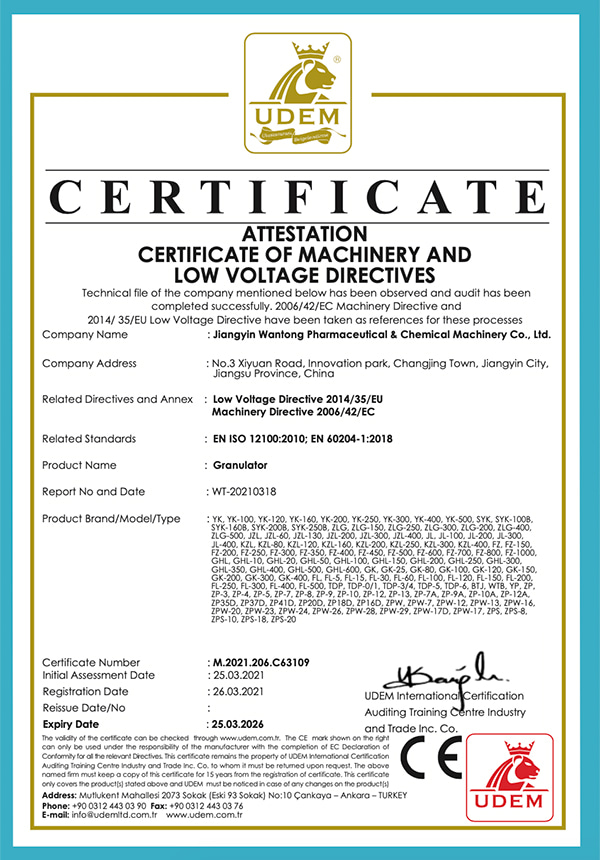Powder Ribbon Blender Mixer Manufacturer
-


WLLD Chemical Powder Ribbon Mixer Machine
The chemical powder ribbon mixer have ribbon blade in the mixing body, when machine work,the ribbon blade will rotary at a very quick speed,... -


WLLD Horizontal Food Powder Ribbon Mixer Blender
The WLLD food powder ribbon mixer machine uses a horizontal ribbon mixer shaft with inner and outer spiral blades. The blades move material... -


WLLD 1000kg industrial dry powder ribbon mixer machine
The 1000kg ribbon mixer is a horizontal type mixing machine,it have many models, the biggest one volume is 15000L, so this mixer machine can...

About Us
Honor
-
 Honor
Honor -
 CE
CE
News
-
Industry News 2025-10-22
1. What a Horizontal Ribbon Mixer Is and Where It’s Used A horizontal ribbon mixer is an industrial ...
View More -
Industry News 2025-10-16
A tray dryer is a batch drying equipment widely used in the pharmaceutical, food, and chemical indus...
View More -
How does a double cone blender compare to ribbon blenders or V-blenders for industrial applications?Industry News 2025-10-09
A double cone blender has distinct advantages and limitations when compared to ribbon blenders and V...
View More -
Industry News 2025-10-01
Electric-Powered Tray Dryers Advantages: Precise and Stable Temperature ControlElectric-powered tr...
View More
Industry Knowledge Expansion
How can you optimize the mixing time and energy consumption in a ribbon mixer?
Optimizing mixing time and energy consumption in a ribbon mixer involves several strategies aimed at achieving thorough mixing while minimizing the use of resources. Here are some ways to achieve this:
Proper Equipment Sizing: Ensure that the ribbon mixer's size and capacity match the production requirements. Using an oversized mixer can lead to longer mixing times and unnecessary energy consumption.
Optimized Agitator Speed: Adjust the speed of the ribbon agitator to the optimal level for the specific material being mixed. Too high a speed may cause excessive energy consumption and unnecessary wear on the equipment, while too low a speed may result in incomplete mixing.
Batch Loading Techniques: Properly load materials into the mixer to maximize the efficiency of mixing. Avoid overloading or underloading the mixer, as this can affect mixing performance and energy consumption.
Material Pre-Processing: Pre-processing materials, such as reducing particle size or pre-mixing certain ingredients, can reduce the overall mixing time and energy required to achieve homogeneous mixing.
Optimized Mixing Sequence: Determine the most efficient mixing sequence for the materials being processed. This may involve adjusting the order in which ingredients are added to the mixer or varying the mixing time for different batches.
Use of Additives: In some cases, the addition of flow aids or lubricants can help reduce friction between particles, resulting in faster mixing and lower energy consumption.
Efficient Heat Transfer: If heat transfer is necessary during the mixing process (e.g., for drying or chemical reactions), optimize the design of the mixer to ensure efficient heat transfer while minimizing energy loss.
Monitoring and Control Systems: Implement monitoring and control systems to continuously assess mixing performance and adjust operating parameters in real-time to optimize mixing time and energy consumption.
Regular Maintenance and Calibration: Keep the ribbon mixer well-maintained and calibrated to ensure optimal performance. This includes checking for worn or damaged parts, lubricating moving components, and calibrating control systems.
Continuous Improvement: Continuously evaluate and improve mixing processes through experimentation, data analysis, and feedback from operators to identify opportunities for optimization and efficiency gains.
What material pretreatment technologies can help the ribbon mixer run more conveniently?
Material pretreatment technologies can significantly impact the efficiency and convenience of ribbon mixers. Here are some methods:
Particle Size Reduction: Pre-grinding or milling larger particles into smaller sizes can facilitate quicker and more uniform mixing in ribbon mixers, reducing processing time and energy consumption.
Moisture Adjustment: Pre-drying or adding moisture to materials to achieve a specific moisture content can improve their flowability and mixing characteristics, leading to more efficient mixing in ribbon mixers.
Deagglomeration: Breaking up agglomerates or clumps in materials prior to mixing can prevent uneven distribution and improve the homogeneity of the final mixture, making the ribbon mixer operation smoother.
Pre-Mixing: Pre-blending ingredients with similar physical properties or those prone to segregation can enhance the overall mixing efficiency of the ribbon mixer, reducing the risk of incomplete mixing or uneven distribution of components.
Surface Treatment: Coating or treating material surfaces with additives or lubricants can reduce friction and improve flow properties, allowing for easier handling and more uniform mixing in ribbon mixers.
Temperature Control: Preheating or cooling materials to a specific temperature range can optimize their viscosity and rheological properties, facilitating better mixing performance and reducing the energy requirements of the ribbon mixer.
Sieving or Screening: Removing oversized particles or foreign contaminants through sieving or screening prior to mixing can prevent equipment damage and ensure smoother operation of the ribbon mixer.



 Español
Español
